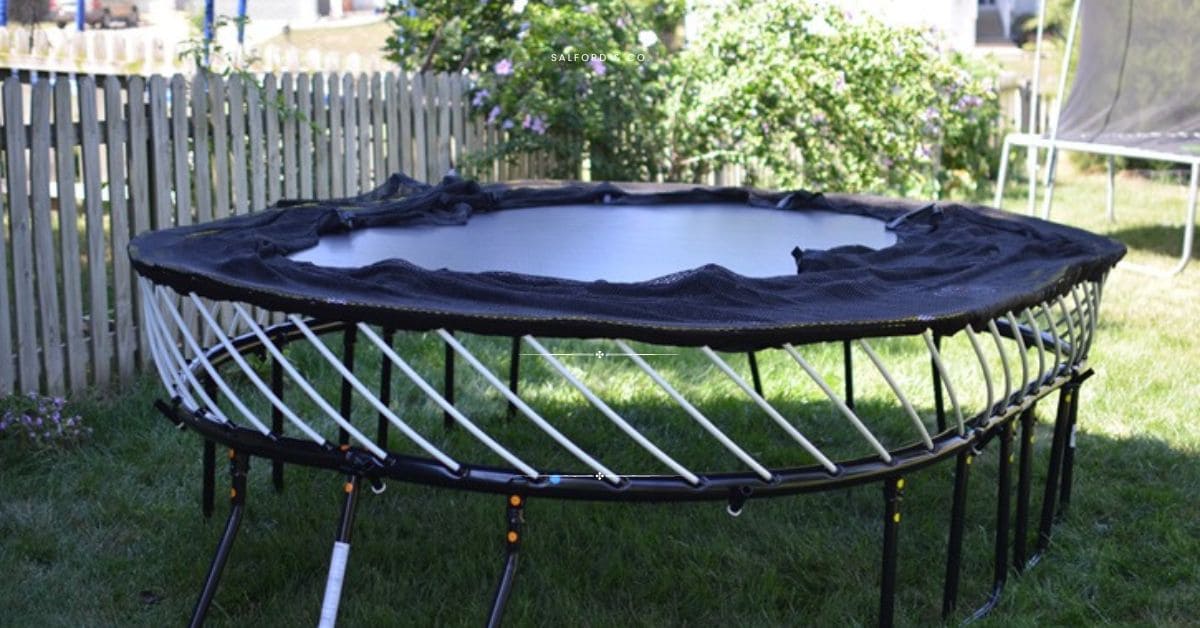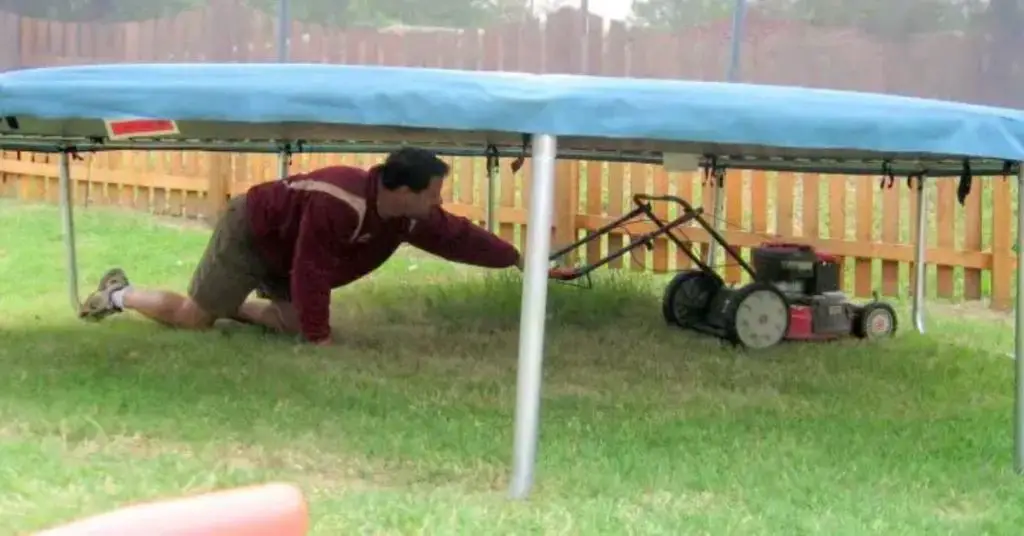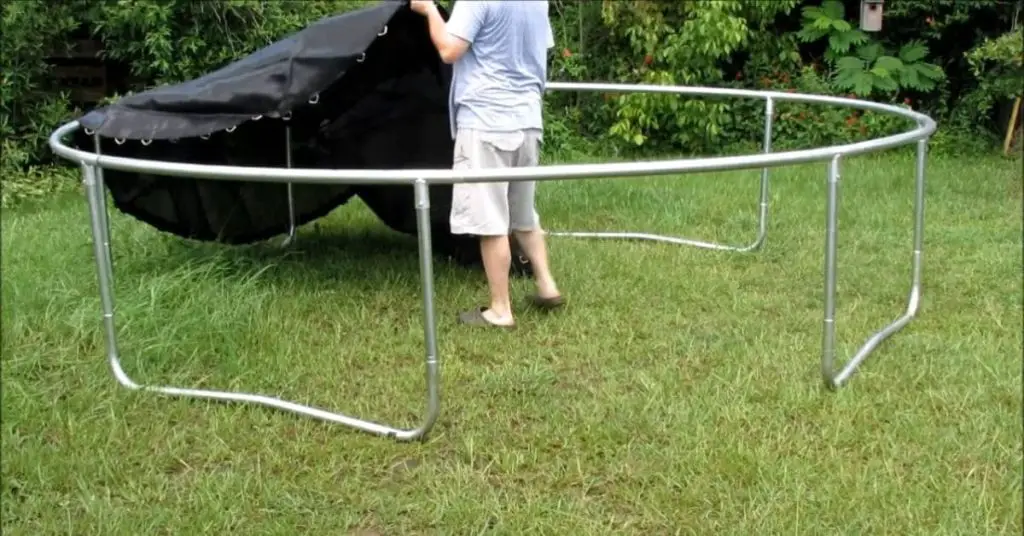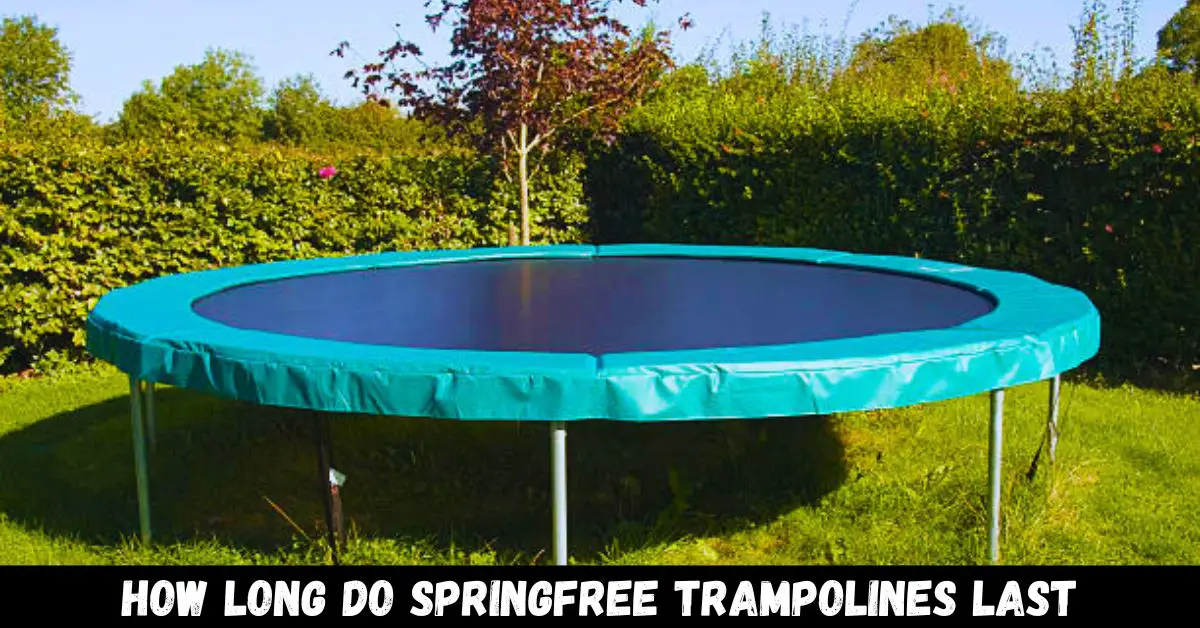One of the common questions that arise when considering purchasing a trampoline is, “How long do Springfree trampolines last?” Springfree trampolines have gained popularity for their innovative design and safety features.
While the exact lifespan of a trampoline can vary based on various factors, including usage, maintenance, and environmental conditions, understanding the typical lifespan of a Springfree trampoline is important for making an informed decision.
In this article, we will explore the typical lifespan of Springfree trampolines, considering both the manufacturer’s claims and real-world experiences. We will also discuss the factors that can either extend or shorten the lifespan of these trampolines.
By gaining insight into the longevity of Springfree trampolines, you can make an informed decision and take the necessary steps to ensure the trampoline’s durability and safety for years of bouncing enjoyment.
How long do springfree trampolines last: Springfree trampolines typically last for 10 to 15 years or longer with proper maintenance. Their high-quality materials and design contribute to their durability, providing years of safe bouncing fun.
How Long Do Springfree Trampolines Last?

Springfree trampolines are known for their durability and longevity. While the exact lifespan can vary based on usage, maintenance, and other factors, these trampolines are designed to last for many years of enjoyment.
On average, a well-maintained Springfree trampoline can last anywhere from 10 to 15 years or even longer. This estimate is based on the high-quality materials used in their construction and the rigorous testing they undergo during manufacturing.
However, it’s important to note that lifespan can be influenced by various factors. Regular maintenance and proper care, such as cleaning the mat and netting, inspecting for damage, and replacing worn-out parts, can help extend the trampoline’s lifespan.
Adhering to weight limits, protecting it from harsh weather conditions, and following the manufacturer’s guidelines for usage also contribute to its longevity.
By taking these factors into consideration and implementing appropriate measures, you can maximize the lifespan of your Springfree trampoline, ensuring years of safe and enjoyable bouncing experiences for your family and friends.
Factors Affecting the Lifespan of Springfree Trampolines
The lifespan of a Springfree trampoline can be influenced by various factors that impact its durability and performance. Understanding these factors is crucial in maintaining the trampoline’s longevity. Here are key elements that can affect the lifespan of a Springfree trampoline:
Quality of Materials Used
The quality of materials used in the construction of Springfree trampolines plays a significant role in determining their lifespan. High-quality materials, such as durable steel frames and UV-resistant fabrics, are essential for ensuring the trampoline’s longevity.
Springfree trampolines are known for using premium-grade materials that are designed to withstand the test of time.
The frame of a Springfree trampoline is typically made of galvanized steel, which is resistant to rust and corrosion. This helps to prevent structural damage and extends the trampoline’s lifespan.
The mat, also known as the jumping surface, is usually made of polypropylene material, which is strong, flexible, and resistant to stretching. The quality of these materials ensures that the trampoline can withstand frequent use and various weather conditions.
Weather Conditions
The weather conditions to which a Springfree trampoline is exposed can have a significant impact on its lifespan. Trampolines that are constantly exposed to harsh elements, such as intense sunlight, heavy rain, or extreme temperatures, may experience accelerated wear and tear.
Prolonged exposure to direct sunlight can cause the mat and safety netting to fade or deteriorate over time. UV rays can weaken the fabric, making it more prone to tearing or fraying.
It is advisable to position the trampoline in a shaded area or use a trampoline cover when it is not in use to protect it from excessive sunlight.
Rain and moisture can also affect the trampoline’s longevity. Excessive moisture can lead to the accumulation of rust on metal components, compromising their structural integrity.
It is important to regularly inspect the trampoline for any signs of rust and promptly address the issue to prevent further damage.
Usage Intensity and Weight Limits
The intensity of usage and adherence to weight limits are crucial factors in determining how long a Springfree trampoline will last. Trampolines are designed to accommodate a certain weight capacity, and exceeding this limit can put undue stress on the structure and components.
Frequent and intense jumping sessions, especially by individuals who exceed the weight limit, can accelerate wear and tear. Overloading the trampoline can lead to stretched springs, a sagging mat, or even structural damage to the frame.
It is important to educate users about the weight limits and ensure that they are followed to maintain the trampoline’s lifespan.
Maintenance and Care

Proper maintenance and regular care are essential for extending the lifespan of Springfree trampolines.
Regular maintenance involves inspecting the trampoline for any signs of wear and tear, addressing issues promptly, and performing routine cleaning.
Inspecting the trampoline regularly allows you to identify any potential problems, such as loose springs or damaged safety netting. Timely repairs can prevent further damage and ensure the trampoline remains safe for use.
Additionally, cleaning the trampoline regularly helps to remove dirt, debris, and potentially corrosive substances that may accumulate over time.
Maintenance also includes following the manufacturer’s guidelines for assembly, disassembly, and storage. Proper assembly ensures that the trampoline is structurally sound, reducing the risk of premature damage.
Disassembling and storing the trampoline during harsh weather conditions, such as storms or winter, can protect it from unnecessary exposure to the elements.
The Typical Lifespan of Springfree Trampolines
The typical lifespan of a Springfree trampoline can vary depending on several factors. While the manufacturer provides an estimated lifespan, real-world experiences, and customer reviews also shed light on the trampoline’s durability. Additionally, certain factors can either extend or shorten the trampoline’s lifespan.
Manufacturer’s Claims
When considering the lifespan of Springfree trampolines, it is important to consider the claims made by the manufacturer. Springfree, a renowned trampoline brand, typically provides information about the expected lifespan of its products.
While the specific lifespan may vary depending on usage and environmental factors, the manufacturer’s claims can serve as a general guideline.
Springfree trampolines are known for their high-quality construction and durability. The manufacturer may state that their trampolines are designed to last for a certain number of years, such as 10 to 15 years or even longer.
These claims are based on extensive testing and the use of premium materials that are resistant to wear and tear.
Real-World Experiences and Customer Reviews
To gain a better understanding of the typical lifespan of Springfree trampolines, it is valuable to consider real-world experiences and customer reviews. Customers who have owned Springfree trampolines for an extended period can provide insights into how well the trampolines hold up over time.
While individual experiences may vary, many customers report that their Springfree trampolines have exceeded their expectations in terms of durability and lifespan.
They often highlight the sturdy construction, high-quality materials, and long-lasting performance of the trampolines. Some customers have reported using their Springfree trampolines for 10 years or more with minimal signs of wear and tear.
However, it is essential to note that usage patterns and environmental factors can influence the lifespan of any trampoline. Factors such as climate, frequency of use, weight limits, and maintenance practices may impact the longevity of the trampoline.
Real-world experiences and customer reviews can provide valuable insights into the overall satisfaction and durability of Springfree trampolines.
Factors that Can Extend or Shorten the Lifespan
Several factors can affect the lifespan of Springfree trampolines, either extending or shortening their expected durability.
Usage Frequency and Intensity:
Trampolines that are subjected to frequent and intense use, such as daily jumping or vigorous exercises, may experience more significant wear and tear. Limiting the intensity and frequency of use can help extend the lifespan of the trampoline.
Weight Limits:
Adhering to the weight limits specified by the manufacturer is crucial for maintaining the structural integrity of the trampoline. Exceeding the weight limits can strain the components and lead to premature damage.
Maintenance and Care:
Proper maintenance and regular care play a vital role in extending the lifespan of Springfree trampolines. Regularly inspecting the trampoline for any signs of wear, addressing issues promptly, and following the manufacturer’s maintenance guidelines can help prevent potential problems and prolong the trampoline’s lifespan.
Environmental Factors:
The climate and weather conditions in the area where the trampoline is located can impact its longevity. Harsh weather elements such as intense sunlight, heavy rain, or extreme temperatures can accelerate wear and tear.
Protecting the trampoline from excessive exposure to these elements, such as using a trampoline cover or positioning it in a shaded area, can help mitigate its effects.
Proper Assembly and Disassembly:

Following the manufacturer’s guidelines for assembly and disassembly is crucial for ensuring the trampoline’s structural stability.
Improper assembly can lead to stress on specific parts, potentially shortening the trampoline’s lifespan.
By considering these factors and taking appropriate measures, such as proper usage, regular maintenance, and protection from environmental factors, it is possible to extend the typical lifespan of Springfree trampolines.
Extending the Lifespan of Springfree Trampolines
Extending the lifespan of your Springfree trampoline is essential to maximize its longevity and continue enjoying safe and fun bouncing experiences. By implementing the following practices, you can help maintain the trampoline’s durability:
Regular Maintenance and Cleaning
Regular maintenance and cleaning are essential for extending the lifespan of Springfree trampolines. By following a few simple steps, you can ensure that your trampoline remains in optimal condition for years to come.
Inspect for Wear and Tear:
Conduct regular inspections of your Springfree trampoline to identify any signs of wear and tear. Check for loose springs, damaged netting, or sagging mats. Promptly address any issues to prevent further damage.
Clean the Mat and Netting:
Dirt leaves and other debris can accumulate on the mat and netting over time. Use a soft brush or broom to sweep away debris, or gently hose down the surface to remove dirt. Avoid using harsh chemicals or abrasive cleaners that can damage the materials.
Check and Tighten Screws and Bolts:
Periodically inspect all screws, bolts, and other fasteners on the trampoline. Make sure they are tightly secured to maintain the trampoline’s stability and structural integrity.
Lubricate Moving Parts:
Lubricate the joints, hinges, and other moving parts of the trampoline as recommended by the manufacturer. This helps prevent squeaking and ensures smooth operation.
Proper Storage During Harsh Weather Conditions
Harsh weather conditions, such as storms, high winds, or heavy snow, can significantly impact the lifespan of your Springfree trampoline. Proper storage during such periods can help protect it from potential damage.
Disassemble If Necessary:
If you live in an area prone to severe weather, consider disassembling the trampoline and storing it indoors or in a secure, sheltered location. Follow the manufacturer’s guidelines for disassembly to ensure proper storage.
Use a Trampoline Cover:
If disassembly is not possible, use a trampoline cover to protect it from the elements. A cover helps shield the mat, netting, and other components from excessive exposure to sunlight, rain, and snow.
Anchor the Trampoline:
Securely anchor the trampoline to the ground using appropriate anchoring systems, especially in areas with strong winds. This helps prevent the trampoline from being blown away or damaged during storms.
Following Weight Limits and Guidelines
Adhering to the weight limits and usage guidelines specified by the manufacturer is crucial for maintaining the structural integrity of your Springfree trampoline.
Follow Weight Limits:
Ensure that the weight limit of the trampoline is not exceeded. Excessive weight can strain the springs, mat, and frame, leading to premature wear and tear. Educate all users about the weight limits and encourage them to adhere to them.
Limit Simultaneous Jumpers:
Avoid overcrowding the trampoline with too many jumpers at once. Overloading the trampoline can increase stress on the components and affect its longevity. Encourage safe and responsible jumping practices.
Avoid Sharp Objects and Shoes:
Discourage users from wearing shoes or bringing sharp objects onto the trampoline. These can puncture the mat or cause other damage. Encourage users to jump barefoot or in soft-soled shoes.
Replacing Damaged or Worn-Out Parts
Over time, certain parts of your Springfree trampoline may wear out or become damaged. Promptly replacing these parts can help extend their lifespan and ensure safety during use.
Springs and Rods:
Inspect the springs and rods regularly for signs of damage, such as rust, stretching, or deformation. Replace any worn-out or damaged springs with new ones to maintain the trampoline’s bounce and performance.
Mat and Netting:
If you notice tears, holes, or significant wear on the mat or netting, consider replacing them. A damaged mat or netting compromises safety and can affect the trampoline’s overall lifespan.
Other Components:
Check the condition of other components, such as the frame, enclosure poles, and padding. If any of these show signs of significant wear or damage, contact the manufacturer or authorized dealer for replacement parts.
By following these maintenance practices and taking proactive measures to protect your Springfree trampoline, you can significantly extend its lifespan, ensuring safe and enjoyable use for years to come.
Springfree Trampolines: Construction and Features
Here are the features of Springfree Trampolines:
Innovative Springless Design
- Patented rod-based technology replaces traditional springs
- Eliminates spring-related issues
- Offers an enhanced bounce experience
SoftEdge Mat Technology
- Absorbs impact upon landing
- Reduces joint stress for users
- Ensures long-lasting durability
Safety-Focused FlexiNet™ Enclosure System
- Ingenious safety enclosure design
- Flexible netting enhances user comfort
- Seamlessly integrates with trampoline frame for stability
Hidden Frame Construction
- Frame positioned beneath jumping surface
- Minimizes collision risks and enhances aesthetics
- Contributes to overall structural integrity
Durable Galvanized Steel Frame
- Corrosion resistance and sturdiness
- Withstands various weather conditions
UV-Resistant Materials
- Safeguards mat and netting from sun damage and fading
Low-Maintenance Design
- Reduces wear and tear points
- Simple cleaning routines ensure longevity
Advantages Of Traditional Trampolines
- Improved safety and user experience
Customization Options and Compatibility
- Accessories available without compromising the lifespan
- Maintains compatibility with the trampoline
Manufacturer’s Warranty and Comprehensive Support
- Backed by a manufacturer’s warranty
- Access to comprehensive customer support
Extended and Enjoyable Lifespan
- Ensures users’ prolonged enjoyment
- Sets new standards for safety and quality.
Signs of Wear and Tear
Signs of wear and tear on a trampoline can indicate that certain components are deteriorating and may require attention or replacement. It’s important to regularly inspect your trampoline for these signs to ensure safety and maintain optimal performance. Here are some common indicators of wear and tear:
Visual Inspection
Performing a visual inspection is a crucial step in identifying signs of wear and tear on your Springfree trampoline. Regularly examine the various components of the trampoline to spot any visible issues.
Check for Tears or Holes:
Inspect the mat and netting for any tears, holes, or fraying. These can compromise the safety and performance of the trampoline. Pay close attention to areas around the springs and attachment points.
Look for Rust or Corrosion:
Examine the frame, springs, and rods for signs of rust or corrosion. Rust can weaken the structural integrity of these components. If you notice any rust, take appropriate measures to address it promptly.
Assess Overall Condition:
Take a step back and evaluate the overall condition of the trampoline. Look for any signs of significant wear, such as faded colors, deteriorating padding, or bent frame sections. These visual cues can indicate that the trampoline is nearing the end of its lifespan.
Loose or Sagging Mat
A loose or sagging mat is a common sign of wear and tear on a trampoline. It can affect the performance and safety of the jumping surface.
Uneven Tension:
Check the mat’s tension by pressing down on it with your hands. The mat should feel firm and evenly tensioned across its surface. If you notice areas with excessive sagging or looseness, it may indicate stretched or worn-out attachment points.
Worn Stitching or Attachments:
Inspect the stitching and attachments that secure the mat to the frame and springs. If you observe any signs of fraying, tearing, or weakened attachments, it is an indication that the mat may need to be repaired or replaced.
Surface Condition:
Examine the surface of the mat for signs of excessive wear, such as thinning areas or exposed inner material. Continuous use and exposure to the elements can cause the mat to degrade over time, affecting its durability and performance.
Springs and Rods Condition
The condition of the springs and rods is essential for maintaining the bounce and stability of the trampoline. Pay attention to these components during your inspection.
Rust or Corrosion:
Examine the springs and rods for any signs of rust or corrosion. Rusty springs can lose their elasticity and affect the trampoline’s performance. Corroded rods may become weak and compromise the overall stability.
Check for Stretching or Deformation:
Look for any signs of stretching or deformation in the springs or rods. Over time, continuous use can cause the springs to stretch or the rods to bend. If you notice any significant changes in their shape, consider replacing them to restore the trampoline’s performance.
Secure Attachments:
Ensure that the springs and rods are securely attached to their respective anchor points. Loose or damaged attachments can lead to instability and increase the risk of accidents.
Safety Net Integrity
The safety net is a critical component of Springfree trampolines, providing a barrier to prevent users from falling off. Inspecting the safety net ensures its continued effectiveness.
Holes or Tears:
Carefully inspect the safety net for any holes or tears. These can compromise its ability to keep users safe. Small holes can be patched, but significant tears may require replacing the netting altogether.
Check the Attachment Points:
Verify that the safety net is securely attached to the frame and poles. Loose or damaged attachment points can affect the net’s stability and compromise its effectiveness.
Tautness of the Net:
The safety net should be properly tensioned to maintain its integrity. Make sure the net is not sagging or overly stretched. Adjust the tension if necessary to ensure a secure and reliable barrier.
Regularly checking the visual condition of your Springfree trampoline, assessing the mat’s tension, inspecting the springs and rods, and ensuring the integrity of the safety net are crucial steps in identifying signs of wear and tear. Promptly addressing any issues will help maintain the trampoline’s safety and longevity.
Recycling and Disposal of Springfree Trampolines
Recycling and disposing of Springfree Trampolines is an important aspect of responsible ownership. When the time comes to replace or get rid of your trampoline, here are some considerations for recycling and proper disposal:
- Donation or Resale: If your Springfree Trampoline is still in good condition and functional, consider donating it to a local community center, school, or charity, or selling it to someone who might find use for it.
- Recycling Metal Components: Trampolines often have metal frames and components that can be recycled. Contact local scrap yards or recycling centers to inquire about metal recycling programs in your area. Disassemble the trampoline to separate metal parts for recycling.
- Local Recycling Programs: Check with your local waste management authorities or recycling facilities to understand their policies on recycling large items like trampolines. Some municipalities offer curbside pickup or designated drop-off locations for large items.
- Disposal of Non-Recyclable Parts: Some trampoline components, such as plastics and padding, might not be recyclable through traditional methods. Research local disposal guidelines and regulations for these materials. Contact local waste disposal services for proper disposal methods.
- Professional Disposal Services: If you’re unable to disassemble or transport the trampoline for recycling or disposal, consider hiring professional services that specialize in removing and disposing of large items.
- Follow Local Regulations: Make sure to follow local regulations and guidelines for disposal. Improper disposal can harm the environment and result in fines.
- Contact Springfree: Reach out to Springfree’s customer service or official website for guidance on responsible disposal or recycling options specific to their products. They might provide information on eco-friendly practices.
- Upcycling: Get creative with repurposing the trampoline components. The metal frame might find new life as a trellis or support structure for garden plants.
- Reduce Waste During Replacement: When getting a new trampoline, consider the environmental impact. Opt for companies that offer sustainable materials or take-back programs to ensure responsible disposal of the old trampoline.
Remember that responsible disposal practices help minimize the environmental impact and contribute to a cleaner and healthier planet. Always prioritize safety when disassembling and disposing of large items like trampolines.
FAQs:
Q1: How long can I expect a Springfree trampoline to last?
Springfree trampolines are known for their durability and longevity. With proper care and maintenance, you can expect a Springfree trampoline to last for many years.
Q2: What factors can affect the lifespan of a Springfree trampoline?
Several factors can influence the lifespan of a Springfree trampoline. These include the quality of materials used, weather conditions, intensity of usage, weight limits, and the level of maintenance and care provided.
Q3: How can I extend the lifespan of my Springfree trampoline?
A5: To maximize the lifespan of your Springfree trampoline, it is essential to perform regular maintenance and cleaning, store it properly during harsh weather conditions, follow weight limits and usage guidelines, and promptly replace any damaged or worn-out parts.
Q4: Can the lifespan of a Springfree trampoline be affected by weather conditions?
Yes, extreme weather conditions, such as strong winds, heavy rain, or prolonged exposure to direct sunlight, can potentially impact the lifespan of any trampoline. Proper storage during severe weather or using a trampoline cover can help protect it from unnecessary damage.
Q5: Do Springfree trampolines come with a warranty?
Yes, Springfree trampolines typically come with a warranty that covers manufacturing defects and structural integrity. The specific warranty terms may vary, so it is recommended to review the warranty details provided by the manufacturer.
Conclusion:
In conclusion, Springfree trampolines are built to withstand years of bouncing fun with proper care and maintenance. The lifespan of a Springfree trampoline can vary based on factors such as the quality of materials used, weather conditions, usage intensity, and adherence to weight limits, as well as regular maintenance and care.
Manufacturers typically claim that Springfree trampolines can last for 10 to 15 years or longer. Real-world experiences and customer reviews support these claims, with many users reporting using their trampolines for over a decade with no major issues.
To extend the lifespan of your Springfree trampoline, it is important to engage in regular maintenance and cleaning. This includes inspecting the trampoline for signs of wear and tear, storing it properly during harsh weather conditions, following weight limits and guidelines, and promptly replacing any damaged or worn-out parts.
By paying attention to these factors and taking proactive steps, you can ensure that your Springfree trampoline remains safe, durable, and enjoyable for many years to come.
Remember to consult the manufacturer’s guidelines and follow best practices to maximize the lifespan of your trampoline and continue to create lasting memories of bouncing fun.
We hope that this guide has helped you understand how long Springfree trampolines can last. If you have any questions, please feel free to leave a comment below.

